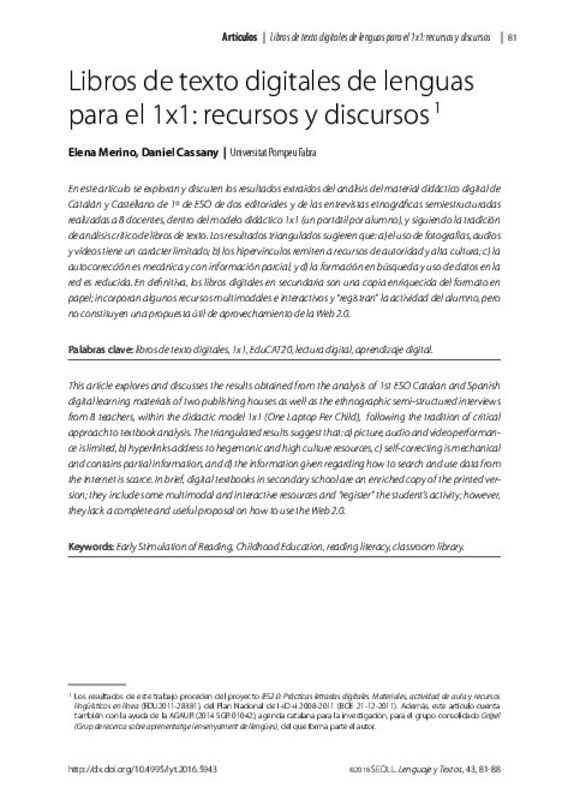JavaScript is disabled for your browser. Some features of this site may not work without it.
Buscar en RiuNet
Listar
Mi cuenta
Estadísticas
Ayuda RiuNet
Admin. UPV
Libros de texto digitales de lenguas para el 1x1: recursos y discursos
Mostrar el registro sencillo del ítem
Ficheros en el ítem
| dc.contributor.author | Merino, Elena
|
es_ES |
| dc.contributor.author | Cassany, Daniel
|
es_ES |
| dc.date.accessioned | 2017-04-28T10:59:18Z | |
| dc.date.available | 2017-04-28T10:59:18Z | |
| dc.date.issued | 2016-06-30 | |
| dc.identifier.issn | 1133-4770 | |
| dc.identifier.uri | http://hdl.handle.net/10251/80212 | |
| dc.description.abstract | [EN] This article explores and discusses the results obtained from the analysis of 1st ESO Catalan and Spanish digital learning materials of two publishing houses as well as the ethnographic semi-structured interviews from 8 teachers, within the didactic model 1x1 (One Laptop Per Child), following the tradition of critical approach to textbook analysis. The triangulated results suggest that: a) picture, audio and video performan-ce is limited, b) hyperlinks address to hegemonic and high culture resources, c) self-correcting is mechanical and contains partial information, and d) the information given regarding how to search and use data from the Internet is scarce. In brief, digital textbooks in secondary school are an enriched copy of the printed ver-sion; they include some multimodal and interactive resources and “register” the student’s activity; however, they lack a complete and useful proposal on how to use the Web 2.0 | es_ES |
| dc.description.abstract | [ES] En este artículo se exploran y discuten los resultados extraídos del análisis del material didáctico digital de Catalán y Castellano de 1º de ESO de dos editoriales y de las entrevistas etnográficas semiestructuradas realizadas a 8 docentes, dentro del modelo didáctico 1x1 (un portátil por alumno), y siguiendo la tradición de análisis crítico de libros de texto. Los resultados triangulados sugieren que: a) el uso de fotografías, audios y vídeos tiene un carácter limitado; b) los hipervínculos remiten a recursos de autoridad y alta cultura; c) la autocorrección es mecánica y con información parcial, y d) la formación en búsqueda y uso de datos en la red es reducida. En definitiva, los libros digitales en secundaria son una copia enriquecida del formato en papel; incorporan algunos recursos multimodales e interactivos y “registran” la actividad del alumno, pero no constituyen una propuesta útil de aprovechamiento de la Web 2.0. | es_ES |
| dc.description.sponsorship | Los resultados de este trabajo proceden del proyecto IES2.0: Prácticas letradas digitales. Materiales, actividad de aula y recursos lingüísticos en línea (EDU2011-28381), del Plan Nacional de I+D+i 2008-2011 (BOE 21-12-2011). Además, este artículo cuenta también con la ayuda de la AGAUR (2014 SGR 01042), agencia catalana para la investigación, para el grupo consolidado Gr@el (Grup de recerca sobre aprenentatge i ensenyament de llengües), del que forma parte el autor. | |
| dc.language | Español | es_ES |
| dc.publisher | Universitat Politècnica de València | |
| dc.relation.ispartof | Lenguaje y Textos | |
| dc.rights | Reconocimiento - No comercial - Sin obra derivada (by-nc-nd) | es_ES |
| dc.subject | Libros de texto digitales | es_ES |
| dc.subject | 1x1 | es_ES |
| dc.subject | EduCAT2 | es_ES |
| dc.subject | Lectura digital | es_ES |
| dc.subject | Aprendizaje digital | es_ES |
| dc.subject | Early Stimulation of Reading | es_ES |
| dc.subject | Childhood Education | es_ES |
| dc.subject | Reading literacy | es_ES |
| dc.subject | Classroom library | es_ES |
| dc.title | Libros de texto digitales de lenguas para el 1x1: recursos y discursos | es_ES |
| dc.type | Artículo | es_ES |
| dc.date.updated | 2016-09-20T12:22:31Z | |
| dc.identifier.doi | 10.4995/lyt.2016.5943 | |
| dc.relation.projectID | info:eu-repo/grantAgreement/MICINN//EDU2011-28381/ES/IES 2.0: PRACTICAS LETRADAS DIGITALES. MATERIALES, ACTIVIDAD DE AULA Y RECURSOS LINGUISTICOS EN LINEA/ | |
| dc.relation.projectID | info:eu-repo/grantAgreement/Generalitat de Catalunya//2009 SGR 0108/ | es_ES |
| dc.rights.accessRights | Abierto | es_ES |
| dc.description.bibliographicCitation | Merino, E.; Cassany, D. (2016). Libros de texto digitales de lenguas para el 1x1: recursos y discursos. Lenguaje y Textos. (43):81-88. https://doi.org/10.4995/lyt.2016.5943 | es_ES |
| dc.description.accrualMethod | SWORD | es_ES |
| dc.relation.publisherversion | https://doi.org/10.4995/lyt.2016.5943 | es_ES |
| dc.description.upvformatpinicio | 81 | es_ES |
| dc.description.upvformatpfin | 88 | es_ES |
| dc.type.version | info:eu-repo/semantics/publishedVersion | es_ES |
| dc.description.issue | 43 | |
| dc.contributor.funder | Ministerio de Economía y Competitividad | |
| dc.contributor.funder | Agencia de Gestión de Ayudas Universitarias y de Investigación | |
| dc.description.references | Bliss, T., Hilton III, J., Wiley, D., & Thanos, K. (2013). The cost and quality of online open textbooks: Perceptions of community college faculty and students. First Monday, 18(1). doi:10.5210/fm.v18i1.3972 | es_ES |
| dc.description.references | Crawford, W. (2006). Why aren't ebooks more successful?, EContent, 29(8), 44-54 | es_ES |
| dc.description.references | Miller, J. R., Nutting, A. W., & Baker-Eveleth, L. (2013). The Determinants of Electronic Textbook Use Among College Students. The American Economist, 58(1), 41-50. doi:10.1177/056943451305800105 | es_ES |
| dc.description.references | Nelson, M.R. (2008). E-books in higher education: Nearing the end of the era of hype?, EDUCAUSE Review, 43, 40-56. | es_ES |
| dc.description.references | Rodríguez Rodríguez, J., Bruillard, E., & Horsley, M. (Eds.). (2015). Digital Textbooks. What’s new? doi:10.15304/op377.759 | es_ES |
| dc.description.references | Taizan, Y., Bhang, S., Kurokami, H., Y KWON, S. (2012). A Comparison of Functions and the Effect of Digital Textbook in Japan and Korea. International Journal for Educational Media and Technology, 6(1), 85-93. | es_ES |
| dc.description.references | Weisberg, M. (2011). Student Attitudes and Behaviors Towards Digital Textbooks. Publishing Research Quarterly, 27(2), 188-196. doi:10.1007/s12109-011-9217-4 | es_ES |








